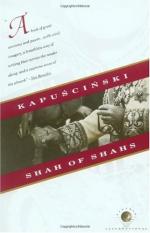|
This section contains 820 words (approx. 3 pages at 400 words per page) |

|
History Repeats Itself
The historical context Kapuscinski establishes conveys a sense that the history of Iran—and to a larger extent, the Middle East—is cyclical. Violence results in revenge, which results in more violence. In this sense, the Shah's oppressive secret police and violation of human rights are just an extension of violence committed by the Shahs before him, as with Agha Mohammed Khan, who orders the entire population of the city of Kerman to be murdered or blinded. The blinded children of Kerman survive to sow seeds of hate in Iranians, stirring notions of revenge that perpetuate the violence. Overall, the revenge narrative is very strong in the Iranian people, and helps to explain how the revolution was possible.
At the end of the book, there is also a sense that the revolution will only bring more of the same misery and oppression to Iran...
|
This section contains 820 words (approx. 3 pages at 400 words per page) |

|




